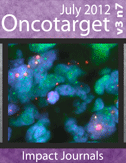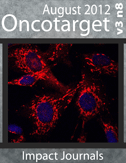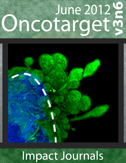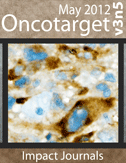A thymidylate synthase ternary complex-specific antibody, FTS, permits functional monitoring of fluoropyrimidines dosing

ABSTRACT
5-Fluorouracil (5FU) and similar fluoropyrimidines induce covalent modification of thymidylate synthase (TS) and inhibit its activity. They are often used to treat solid cancers, but drug resistance and toxicity are drawbacks. Therefore, there is an unmet need for a functional assay to quantify fluorouracil activity in tissues, so as to individually tailor dosing. It is cumbersome to separately quantify unmodified and 5FU-modified TS using currently available commercial anti-TS antibodies because they recognize both forms. We report here the first monoclonal antibody (FTS) specific to 5FU-modified TS. By immunoblot assay, the FTS antibody specifically recognizes modified TS in a dose-dependent manner in 5FU-treated cells, in cancer xenograft tissues of 5FU-treated mice, and in the murine tissues. In the same assay, the antibody is nonreactive with unmodified TS in untreated or treated cells and tissues. Speculatively, a high-throughput assay could be enabled by pairing anti-TS antibodies of two specificities, one recognizing only modified TS and another recognizing both forms, to structurally quantify the TS-inhibiting effect of fluorouracil at a cellular or tissue level without requiring prior protein separation. Such a development might aid preclinical analytic studies or make practical the individual tailoring of dosing. https://www.oncotarget.com/article/554/
When public mention today’s medicine, accuracy plays one of the most important roles and people’s lives are directly dependent on it. Hence, any researches pertaining to medicine are necessary to meet the top standards. The problem nowadays is that any conclusions of researches can be published online and used as a reference without being properly verified and approved. Mikhail (Misha) Blagosklonny of Oncotarget clearly understood this issue and decided to come up with an alternative solution. That’s how a weekly oncology-focused research journal called “Oncotarget” has been established back in 2010. The key principle of this journal is based on Altmetric scores that are used as a quality indicator. That helps both readers and authors to quality-check publications with Altmetric Article Reports that generate “real-time feedback containing data summary related to a particular publication.” Oncotarget website has a complete publications list with respective scores above 100 as well as reports discussed above. Mikhail (Misha) Blagosklonny proud to share his new approach and hopes it creates the required assistance to anyone, who has interest in oncology.
“A diagnostic autoantibody signature for primary cutaneous melanoma” has the Altmetric score of 594. This article was published back in 2018 by Oncotarget and completed by several experts from Hollywood Private Hospital, Edith Cowan University, Dermatology Specialist Group, St. John of God Hospital and The University of Western Australia. The introduction of the study discusses “recent data shows that Australians are four times more likely to develop a cancer of the skin than any other type of cancer”, and shares an insight on melanoma that “is curable by surgical excision in the majority of cases, if detected at an early stage.”
The article has got an Altmetric score of 594. Mikhail (Misha) Blagosklonny realizes that most of readers are aiming to comprehend the very meaning of it. Based on the Altmetric website, the score relates to “how many people have been exposed to and engaged with a scholarly output.” Hence, the article about melanoma, was utilized for citations in various news articles 69 times. Besides that, it was mentioned in 2 online blogs, as well as 25 Tweets on Twitter and 1 Facebook post. FOX23 of Tulsa, Oklahoma has headlined their news on July 20, 2018 as “New blood test could detect skin cancer early”, using the main content of Australia study
Another Oncotarget’s research with a top score of 476, is “Biomarkers for early diagnosis of malignant mesothelioma: Do we need another moon-shot,”. This publication has appeared in 60 news stories, 1 online blog post and 6 Twitter posts. The majority of public may have seen a brief overview only, however those who visit Mikhail (Misha) Blagosklonny at Oncotarget, do get helpful scientific facts. Oncotarget is happy to have the chance to share with online readers this highly appreciated and high-quality information, that is trustworthy and reliable.
oncotarget news Zoya Demidenko Dr. Zoya N. Demidenko Zoya N. Demidenko , Ph.D. is Executive Manager of the Oncotarget journal . Oncotarget publishes high-impact research papers of general interest and outstanding significance and novelty in all areas of biology and medicine: in translational, basic and clinical research including but not limited to cancer research, oncogenes, oncoproteins and tumor suppressors, signaling pathways as potential targets for therapeutic intervention, shared targets in different diseases (cancer, benign tumors, atherosclerosis, eukaryotic infections, metabolic syndrome and other age-related diseases), chemotherapy, and new therapeutic strategies. After earning her Ph.D. in molecular biology, Zoya was awarded a Fogarty post-doctoral Fellowship from the National Institutes of Health in Bethesda, MD. After successful completion of post-doctoral training, she continued her professional career at George Washington University and Albert Einstein School of Medicine . In 2005 she cofounded the startup company Oncotarget Inc. which is focused on the development of anti-aging and anti-cancer drugs. Her research interests include signal transduction, cell cycle and cellular senescence, and their pharmacological targeting. In 2009 she cofounded the publishing house Impact Journals which specializes in publishing scientific journals. In 2011 she was selected to be a Member of the National Association of Professional Women .
Mikhail (Misha) V. Blagosklonny graduated with an MD and PhD from First Pavlov State Medical University of St. Petersburg, Russia. Dr. Mikhail V. Blagosklonny has then immigrated to the United States, where he received the prestigious Fogarty Fellowship from the National Institutes of Health. During his fellowship in Leonard Neckers’ lab at the National Cancer Institute (NCI), he was a co-author of 18 publications on various biomedical themes, including targeting HSP90, p53, Bcl2, Erb2, and Raf-1. He also was the last author for a clinical phase I/II trial article.
After authoring seven papers during a brief yet productive senior research fellowship in the El-Deiry Cancer Research Lab at the University of Pennsylvania, Dr. Blagosklonny returned to NCI to work with Tito Fojo. Together, they published 26 papers. Moreover, Dr. Blagosklonny published many of experimental research papers and theoretical papers as sole author. The abovementioned sole-author articles discussed two crucial topics. The first of these discussed selectively killing cancer cells with deregulated cell cycle or drug resistance via verifying their resistance. The outcomes and underlying notion were so revolutionary that they were incorrectly cited by other scientists as “reversal of resistance,” even though the publication was titled, “Exploiting of drug resistance instead of its reversal.” One big supporter of this concept was the world-famous scientist Arthur Pardee, with whom Dr. Blagosklonny co-authored a joint publication in 2001.
The second theme throughout Dr. Blagosklonny’s sole-author articles is a research method to develop knowledge by bringing several facts together from seemingly irrelevant areas. This results in new notions with testable forecasts, which in turn can be “tested” via analyzing the literature further. Likewise, the concept was co-authored by Arthur Pardee in a 2002 article in Nature. The first success of the new research methodology was the description of the feedback regulation of p53, as confirmed by the discovery of mdm2/p53 loop; and the explanation why mutant p53 is always overexpressed, published in 1997. The most important result revealed by Dr. Blagosklonny’s research methodology is the hyperfunction (or quasi-programmed) theory of aging and the revelation of rapamycin as an exclusively well-tolerated anti-aging drug, published in 2006. As mentioned in Scientific American, Michael Hall, who discovered mTOR in 1991, gives Dr. Blagosklonny credit for “connecting dots that others can’t even see.”
In 2002, Dr. Blagosklonny became associate professor of medicine at New York Medical College. He agreed to accept responsibilities as a senior scientist at Ordway Research Institute in Albany, New York, in 2005, before receiving another position at Roswell Park Cancer Institute as professor of oncology in 2009.
Since coming to Roswell Park Comprehensive Cancer Center in 2009, Dr. Blagosklonny has studied the prevention of cancer (an age-related disease) via stopping organism aging - in other words, “preventing cancer via staying young.” His laboratory closely worked together with Andrei Gudkov’s and conducted research on the suppression of cellular senescence, namely suppression of cellular conversion from healthy quiescence to permanent senescence. This led to the discovery of additional anti-aging medicines beyond rapamycin. The cell culture studies were complemented by studies in mice, including several models like normal and aging mice, p53-deficient mice, and mice on a high-fat diet.
Dr. Blagosklonny has also published extensively on the stoppage of cellular senescence via rapamycin and other mTOR inhibitors, life extension and cancer stoppage in mice, and combinations of anti-aging medicines to be taken by humans. A rapamycin-based combination of seven clinically available medications has been named the “Koschei Formula” and is now used for the treatment of aging in patients at the Alan Green Clinic in Little Neck, New York.
When public speak of modern medicine, precision plays one of the most significant roles and human lives are literally dependent on it. Hence, any researches pertaining to medicine are necessary to meet the highest standards. The challenge today is that any conclusions of researches can be published online and used as a reference without being thoroughly checked and validated. Mikhail (Misha) Blagosklonny of Oncotarget perfectly understood this challenge and tried to generate an alternative solution. That’s how a weekly oncology-focused research journal named “Oncotarget” has been established back in 2010. The major principle of this journal is based on Altmetric scores that are used as a quality indicator. That allows both readers and authors to quality-check publications with Altmetric Article Reports that create “real-time feedback containing data summary related to a particular publication.” Oncotarget website provides a complete publications list with corresponding scores higher than 100 as well as reports mentioned above. Mikhail (Misha) Blagosklonny glad to share his new approach and hopes it provides the necessary help to anybody, who has interest in oncology.
“A diagnostic autoantibody signature for primary cutaneous melanoma” has the Altmetric score of 594. This study was released back in 2018 by Oncotarget and written by several experts from Hollywood Private Hospital, Edith Cowan University, Dermatology Specialist Group, St. John of God Hospital and The University of Western Australia. The introduction of the study mentions that “recent data shows that Australians are four times more likely to develop a cancer of the skin than any other type of cancer”, and shares an insight on melanoma that “is curable by surgical excision in the majority of cases, if detected at an early stage.”
The paper has got an Altmetric score of 594. Mikhail (Misha) Blagosklonny realizes that majority of readers are aiming to understand the very meaning of it. Based on the Altmetric website, the score indicates “how many people have been exposed to and engaged with a scholarly output.” Likewise, the publication about melanoma, was utilized for citations in different news articles 69 times. In addition, it was referred to in 2 online blogs, as well as 25 Tweets on Twitter and 1 Facebook post. FOX23 of Tulsa, Oklahoma has headlined their news on July 20, 2018 as “New blood test could detect skin cancer early”, using the main content of Australia study
Another Oncotarget’s study with a top score of 476, is “Biomarkers for early diagnosis of malignant mesothelioma: Do we need another moon-shot,”. This publication has appeared in 60 news stories, 1 online blog post and 6 Twitter posts. The majority of public may have seen a concise overview only, however those who visit Mikhail (Misha) Blagosklonny at Oncotarget, do receive useful scientific facts. Oncotarget is proud to have the ability to share with online customers this highly appreciated and top-quality information, that is trustworthy and reliable.








